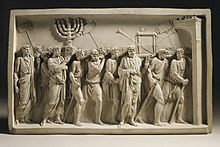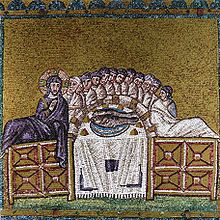Table (bible)
The table ( Hebrew שֻׁלְחָן schulchan , ancient Greek τράπεζα trápeza ) is an extraordinary piece of furniture in the biblical worlds, because a normal meal of ordinary people was consumed while sitting on the floor, with the food on a mat.
The occurrence of the word “table” therefore refers to the area of cult, the royal court or the upper class in general. A guest room with a bed, table, chair and a chandelier ( 2 Kings 4,10 LUT ) could set up only wealthy host, it is "equipped with at that time downright luxurious furnishings." The fact that a family in their own home around the table sits ( Ps 128 , 3 LUT ), is not to be taken for granted, but rather "as the effect of YHWH's blessing".
Tables as ritual objects

The table of showbread part according to biblical representation ( Ex 25.23 to 30 LUT ) to the inventory of the Mischkan . In addition to the seven-armed candlestick ( menorah ), it became a symbol of the Jewish religion during the Second Temple and was carried along in Titus' triumphal procession because of this importance. Antigonus the Hasmonean had the showbread table depicted on coins. This was a relatively small table made of gold with a rectangular top and four legs, the legs of the narrow sides being connected to one another by a bar. In the opinion of Alexander Ernst, this bracing is meant by the term מסגרת misgeret in verse 25, which is usually understood as the "edge strip" (= circumferential strip of the table top).
In addition, there were tables in the Second Temple, made of marble, among other things, which served as storage space, on the one hand for serving the showbread table (changing the showbread on the table ) and on the other hand as workplaces where the sacrificial animals were skinned. Such work tables describes Ezekiel's temple vision ( Ez 40,39–43 LUT ), from which it emerges that square stone podiums are meant. The detailed representation is seen as a late addition to the text, "which perhaps found its way into the Book of Ezekiel due to the actual course of the cult at the Second Temple".
Difficult to classify are the "silver tables " mentioned only in an addition to the 1st chronicle ( 1 Chr 28,14-18 LUT ). Its meaning is unknown.
Tables as luxury furniture

The closest visual material to the shape of the dining table in the Old Testament consists of Iron Age reliefs from northern Syria and southeastern Anatolia, on which dining table scenes are depicted. Because of the two-dimensional representation, construction details of the tables remain unknown, for example the square or rectangular shape of the table top.
Word and thing are very old in Syria and Palestine. The earlier interpretation that שֻׁלְחָן schulchan was derived from the verb שלח and originally referred to something stretched out on the floor, an “eating leather”, has been dealt with since it was known that the related word ṯlḥn is a common name for the table in Ugarit .
The dining table of the Aḥiram of Gebal was a square table of the Mesopotamian type. The S-shaped curved table legs end in lion feet, a table shape popular in the region for a long time. As an additional detail, a central support can be seen on the relief, which is braced horizontally with the table legs. There is no corresponding image material for ancient Israel, but "one can think of - mostly small - square (?) Wooden tables."
The side table had assumed a special shape under the influence of the Halacha, which had developed since the Hellenistic period . From excavations in Jerusalem ( house of the Qathros family , Herodian quarters ) the type of stone table with a rectangular top on a column-like or pillar-like leg is known. The limestone material could not accept any cultic impurity.
A round table top made of limestone was also found in the Herodian quarter, which must have belonged to a three-legged round table. Such tables were known under the name delphica in the Greco-Roman context and combined different materials (in this case wood and limestone).
Three round limestone trays without handles are also known from the Temple Mount Excavation, for which use as a serving tray or removable tabletop of a three-legged table is assumed.
Tables and communal meals

Old testament
In the Old Testament, a table outside of the cult is usually referred to as a table of a high-ranking person. To be part of this is an honor. Examples:
- The sons of Jacob are honored with food from Joseph's table ( Gen 43,34 LUT );
- David can be excused at Saul's table and thus arouses the king's anger ( 1 Sam 20 : 18–34 LUT );
- Wisdom rule for guests at the table of a ruler ( Prov 23.1 LUT ).
The formulation ערך שֻׁלְחָן“Setting the table” (examples: Ps 23,5 LUT ; Isa 21,5 LUT ) lets expect a feast. In particular, God is described in the Old Testament as a generous host who richly entertains the believers. The background to this picture is the experience of meals at the temple.
The grave stele of priest Si Gabbor in the Louvre (photo) comes from the environment of the Old Testament (temporally and spatially ). It's a banquet scene: Si Gabbor is holding a drinking bowl in his hand, and in front of him is a luxurious little table with other dishes. A servant gives him air.
New Testament

In New Testament times, banquets or communal dinners were occasions on which ordinary people also had the opportunity to dine at a festive table.
The community rule of the Jachad (1 QS VI 2–8) describes regular meals in which at least ten men sit at a table in the order of their rank (not lie).
On the other hand, the New Testament meals are more likely to be lying at the table ( triclinium ). While sitting at the table might have been more common in the world of Jesus of Nazareth , as 1 QS shows, the Gospel writers envision a table fellowship at table, and this is sometimes important in understanding the plot. The painting by James Tissot “The meal in the house of the Pharisee ” illustrates how a woman can step up to the table from behind unnoticed and anoint Jesus' feet ( Lk 7,37-38 LUT ).
The earliest depictions of millers in Christian art prefer the variant of the sigma-shaped triclinium. If Jesus Christ has the place of honor as host in this representation, this is not the place in the middle, as in later artistic representations, but the place on the left side of the table when viewed from the viewer.
The word table in the New Testament usually means the dining table , it can be used in the sense of “ meal ” ( Acts 16:34 LUT ).
The table on which the changer lays out his coins is used in a completely different way, so that the table in Lk 19.23 LUT can be the " bank " in the word, in multiple senses , on which one deposits his money.
reception
- In Tabgha , a piece of rock is venerated as the cafeteria Domini , "Lord's Table". Jesus is said to have placed fish and loaves on this stone when he fed the five thousand .
- Schulchan Aruch "Gedeckter Tisch", the main work of the Jewish religious law.
literature
- Roland Deines : Jewish stone vessels and Pharisaic piety. An archaeological-historical contribution to the understanding of John 2,6 and the Jewish purity halacha in the time of Jesus (= WUNT, 2nd row, 52). Mohr Siebeck, 1993, ISBN 9783161460227 ( limited preview in Google book search ), pp. 238–241.
- Alexander Ernst: Art. שֻׁלְחָן šulḥān . In: G. Johannes Botterweck , Helmer Ringgren, Heinz-Josef Fabry (Hrsg.): Theological dictionary to the Old Testament (ThWAT). Volume VIII. Stuttgart a. a. 1995, pp. 71-79.
- Friedhelm Hartenstein: "Bread" and "Table of the Face". On the logic of symbolic communication in the temple ritual. In: Johannes F. Diehl et al. (Ed.): "Make me an altar of earth ...". Festschrift for Diethelm Conrad on his 70th birthday. Small works on the Old and New Testament, Vol. 4. Waltrop 2003, pp. 107–127. ISBN 978-3-89991-010-0 .
- Othmar Keel : The world of ancient oriental pictorial symbolism and the Old Testament. Using the example of the psalms. Vandenhoeck & Ruprecht, Göttingen 1972, ISBN 3-525-53638-0 .
- Wolfgang Zwickel : The world of the Old and New Testaments. Calwer Verlag, Stuttgart 1997, ISBN 3-7668-3412-6 .
Web links
- Table in the Bible (82 references)
- Erika Fischer: Furniture
Individual evidence
- ↑ Erika Fischer: Furniture. P. 23 , accessed April 16, 2018 .
- ↑ Wolfgang Zwickel: The world of the Old and New Testaments . S. 27 : "The life of the common people, on the other hand, took place on the floor."
- ↑ a b c Alexander Ernst: Art. שֻׁלְחָן šulḥān . Sp. 74 .
- ^ Walter Dietrich: 2nd Kings . In: Evangelical Reformed Church of the Canton of Zurich (ed.): Explained - the commentary on the Zurich Bible . tape 1 . Theological Publishing House Zurich, Zurich 2010, p. 817 .
- ↑ Antigonus (Mattathias) (40–37 BC). In: Coin and Power (exhibition). Kunsthistorisches Museum Wien, accessed on April 16, 2018 .
- ↑ a b Alexander Ernst: Art. שֻׁלְחָן šulḥān . Sp. 76 .
- ↑ Roland Deines: Jewish stone vessels . S. 239 .
- ↑ Erika Fischer: Furniture. P. 24 , accessed on 16 April 2018 .
- ^ André Flury: Ezekiel . In: Evangelical Reformed Church of the Canton of Zurich (ed.): Explained - the commentary on the Zurich Bible . tape 2 . Theological Publishing House Zurich, Zurich 2010, p. 1740 .
- ↑ Alexander Ernst: Art. שֻׁלְחָן šulḥān . Sp. 71 .
- ^ Wilhelm Gesenius: Hebrew and Aramaic concise dictionary on the Old Testament . Ed .: H. Donner. 18th edition. Berlin / Heidelberg 2013, pp. 1363 .
- ↑ Alexander Ernst: Art. שֻׁלְחָן šulḥān . Sp. 72 .
- ↑ a b Erika Fischer: Furniture. P. 17 , accessed April 20, 2018 .
- ↑ Erika Fischer: Furniture. P. 17 , accessed on 16 April 2018 .
- ↑ Roland Deines: Jewish stone vessels . S. 241 .
- ↑ Erika Fischer: Furniture. Pp. 23–24 , accessed April 16, 2018 .
- ↑ Othmar Keel: The world of ancient oriental pictorial symbolism . S. 174 .
- ↑ Stele of the priest Si Gabbor. In: Department of Near Eastern Antiquities: Levant. Louvre, accessed April 16, 2018 (French).
- ^ Daniel Stökl Ben Ezra: Qumran . Mohr Siebeck, Tübingen 2016, ISBN 978-3-8252-4681-5 , p. 296 .
- ↑ Wolfgang Zwickel: The world of the Old and New Testaments . S. 58 .
- ↑ Guido Fuchs: grinding culture. Grace and table ritual . Friedrich Pustet, Regensburg 1998, p. 171-172 .
- ↑ a b Walter Bauer: Greek-German dictionary on the writings of the New Testament and early Christian literature . Ed .: Kurt Aland, Barbara Aland. 6th edition. Walter de Gruyter, Berlin / New York 1988, ISBN 3-11-010647-7 , Sp. 1643 .

